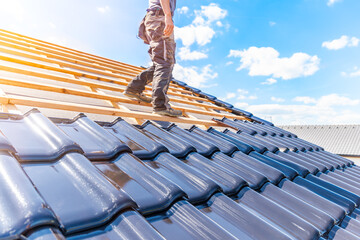Many homeowners find it challenging to decide whether to repair or replace their roofs. Is it better to repair the damage, or would a full replacement be more cost-effective in the long run? Localized problems like missing shingles or leaky spots can often be repaired. However, a roof that’s nearing the end of its expected lifespan should be replaced to avoid major issues down the road. Go to your local Lakewood Roofing Contractor to learn more.
Roofing Materials
 The type of roofing materials you choose for your home will impact its appearance, longevity, energy efficiency, and overall value. The field of options is vast, but it can narrow considerably when you consider your budget and what’s typically installed in your area. Your choice also depends on whether you want to add architectural style, extra structural support, or climate compatibility to your roof’s protection.
The type of roofing materials you choose for your home will impact its appearance, longevity, energy efficiency, and overall value. The field of options is vast, but it can narrow considerably when you consider your budget and what’s typically installed in your area. Your choice also depends on whether you want to add architectural style, extra structural support, or climate compatibility to your roof’s protection.
Asphalt shingles are the most popular roofing material in America and offer a range of styles and colors. They’re durable, affordable, and work well in most climates. They are made from a combination of sand, clay and water and can be reinforced with fiberglass for additional strength. Concrete tile offers a classic, attractive look and is available in several different color combinations. It is very durable and can last for over 50 years.
Metal roofs come in a variety of styles and can be made to mimic traditional shingle, wooden shake or slate roofs. They’re known for their durability, longevity and resistance to fire and extreme weather conditions. They’re often more expensive than other roofing materials, but can be a cost-effective choice in the long run.
A newer type of roofing material is synthetic wood shingles, which are made from recycled plastic or rubber materials and designed to look like authentic wood shingles. They’re more durable than natural shingles, and they don’t need to be treated or painted, which cuts down on maintenance costs.
Rolled roofing is a basic form of roofing that consists of large rolls of asphalt-impregnated and mineral-granule-topped material. It’s inexpensive, and it works well for low-sloped residential roofs as well as outbuildings like sheds and garages.
Other options include tile, which is made from clay, granite, terracotta or other natural materials and can be painted to match any color scheme. It’s heavy and can reduce a house’s energy efficiency, but it can add to the value of your home and is resistant to fire, insects, rot and fungus. A newer variation on this is “laminate” tile, which combines the benefits of natural materials with the lightweight and durability of an asphalt shingle.
Roofing Installation
Your roof keeps you, your family, and your belongings safe from the elements. It provides insulation, protects the interior of your home from pests, and reduces heating and cooling costs. But over time, your roof can experience wear and tear that leads to deterioration and the need for repairs or replacement.
Roofing contractors can help you determine whether repair or replacement is the right choice for your property. The first step is to assess the overall condition of your roof. Look for signs of widespread shingle damage, a sagging roof structure, or excessive leaks. In some cases, these issues may require a full roof replacement rather than simply repairing isolated areas of damage.
A full roof replacement involves the complete removal of existing shingles, and often the entire roof deck. Then the new roofing material is installed, including underlayment and flashing. Qualified roofers install these elements properly to prevent moisture intrusion that can compromise the longevity of the new roof materials.
When choosing the new roofing material, consider the climate in your region, as well as the type of home you have. Asphalt shingles are inexpensive and easy to replace, but they may not be durable in harsh climates. Metal roofs, on the other hand, are more expensive but provide superior durability. They are also an excellent choice for low-pitched roofs.
Once the new roofing material is installed, a qualified roofer will inspect the installation for any underlying issues. Then he or she will apply the appropriate caulking, sealant, and shingle adhesives. In many cases, a roof will be covered with a layer of underlayment to prevent water infiltration and prolong the life of the new shingles.
In addition to these components, a qualified roofer will install ridge vents and valley vents as needed. He or she will also remove and dispose of the old shingles, and protect the foundation plantings and landscaping with tarps. If your property has a drip edge or gutter system, the roofer will remove the old materials and replace them as needed. In the end, you’ll enjoy a beautiful new roof that provides enhanced energy efficiency and improved aesthetics.
Roofing Repair
As the barrier that protects your home from sun, wind, rain, snow, and pests, your roof is essential to keeping you safe and comfortable. Unfortunately, it isn’t immune to wear and tear over the years, leading to damaged shingles or leaks that can cause significant damage to your house and its contents. When that damage occurs, you need to decide whether it’s time for a repair or replacement.
If the problem is limited to a single section or only a few shingles, a repair may be your best option. A quick fix can stop leaks and help your roof last several more years.
However, repairing only the damaged areas can leave a patchwork effect that’s not ideal if aesthetics are important. Also, replacing only a few shingles without addressing the root cause could lead to recurring problems and costly repairs down the road.
Roofing companies can offer other options when the damage is more widespread or if you’re looking to add value to your home in the future. One of these is a partial replacement, in which only the old shingles in a particular area are removed and replaced with new ones. However, this method can be difficult to match shingles because the color is exposed more than they would be under an existing cover.
Another option is a full roof replacement, which involves removing all the shingles and felt paper or moisture barrier and replacing them with brand new materials. This can be more cost-effective than a repair because it doesn’t require the removal of any other damaged areas that may be discovered when tearing off the old roof.
A full replacement is generally only recommended if your roof is nearing the end of its lifespan or if it’s been compromised by extensive storm damage or extreme wear. A poorly functioning roof can cause a number of expensive and inconvenient problems for your family, including leaks, mold and mildew, and higher heating or cooling bills. A well-executed replacement can add resale value to your home and give you peace of mind for the years ahead.
Roofing Replacement
If your roof is nearing the end of its expected lifespan or suffers severe damage from a storm, it’s usually best to replace it. This allows you to select a new roofing material, and ensures that any underlying problems are addressed. The removal of the old roofing materials is also an excellent opportunity to add ventilation systems and improve the energy efficiency of your home.
A complete replacement is generally more expensive than repairing the damaged areas, as every old shingle and piece of roof material will need to be removed before the installation process can begin. However, replacing a section of the roof is less invasive and will typically result in a lower quote.
Whether it’s due to age or a recent storm, the color of your shingles can fade over time. If you notice a patch of missing or cracked shingles, it’s important to replace them immediately. This will prevent water from penetrating your roof and causing further problems, as well as improving the aesthetic of your home.
However, if your roofing contractor recommends replacing the entire roof, it’s worth considering the pros and cons of this option. A full replacement will typically have a longer lifespan than your existing roof and will improve the overall structural integrity of your home. It’s also often a more environmentally responsible option, as it reduces the amount of waste sent to landfills.
Re-roofing involves adding a new layer of shingles over the existing one, which is typically done when the majority of the roof is in good condition. However, it’s important to remember that covering up any damaged materials will not stop further damage from occurring, and can actually make the problem worse. It’s also difficult to find exact color matches when re-roofing, which can lead to a patchy and discolored appearance. Finally, re-roofing can void or shorten your warranty on the new shingles. This means that if you’re experiencing significant structural damage, a full roof replacement may be your only option.


